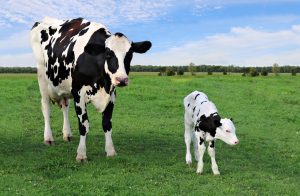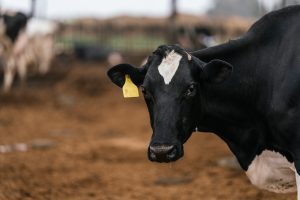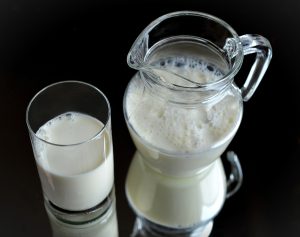Fernando Diaz
Introduction
The most recent nitrogenous formulation systems for dairy cows are based on the concepts of digestible protein in the intestine11 and the contribution of amino acids to the small intestine of ruminants19,23,17. The interest in improving the precision of the protein formulation in these animals has depended not only on the need to continue improving production and reducing costs but also, in recent times, on the need to reduce the environmental impact of the excessive amount of nitrogen in diets3,23,27.
The contributions of protein or amino acids to the small intestine of dairy cattle correspond in all systems to the sum of the microbial protein synthesized in the rumen, the feed protein not degraded in it, and the endogenous protein6. The complexity of the factors that affect the flow of each of these fractions makes it very difficult to predict the quantity and profile of the amino acids that flow into the small intestine of the ruminant13, as unlike the monogastric, the amino acid composition of the protein available to the animal depends on the nature of the protein that leaves the rumen and not on that which the animal digests10.
Environmental pollution from nitrogen in animal production systems
One of the main environmental problems is the emission of nitrogen (N) into the environment8. Nitrogen is a chemical element that cannot be produced or destroyed by animal metabolism and only molecules that contain it can be transformed21. Most of the N that animals consume is excreted, at which point it becomes a necessary nutrient for plant growth. However, the main problem during this N cycle is that high N losses contribute to the degradation of the environment22. The highest N losses that occur in intensive animal production systems are the result of the emission of gases into the atmosphere and the runoff of nitrates (NO3–) to surface water and groundwater. The main atmospheric pollutants that originate in animal production systems are detailed below18:
- Ammonia (NH3): The urea present in animals’ urine is hydrolyzed to NH3 and carbon dioxide, facilitated by the urease enzymes found in feces. Once it has been emitted, NH3 can be rapidly converted to the ammonium ion (NH4+). NH4+ contributes to the eutrophication, acidification, and fertilization of ecosystems. Forty-eight percent of NH3 emissions into the environment comes from production animals.
- Nitrous Oxide (N2O): N2O is formed and emitted into the atmosphere through the microbial processes of nitrification and de-nitrification occurring in the soil. This gas warms the troposphere and results in the loss of ozone in the stratosphere. One-third of the amount of this pollutant comes from animal farms.
- Nitric Oxide (NO): NO and nitrogen dioxide (NO2) are rapidly released into the atmosphere and are therefore referred to as NOX. Emissions of this gas from animals and their excreta are very low, representing 1% of total emissions.
Degradation of the protein in the rumen
The degradation of dietary protein in the rumen is a complex process that involves many microorganisms, which provide the necessary enzymes to hydrolyze the peptide bonds that generate peptides and aminoacids30. These products of ruminal degradation are transported within the microbial cells and follow the following metabolic pathways2:
- Peptidases degrade the peptides into amino acids.
- According to the energy (in the form of carbohydrates) available in the microbial cell, the amino acids can be used in the synthesis of MP or can be deamidated, producing NH3 and carbon skeletons, which are fermented into volatile fatty acids and CO2.
Protein degradation in the stomach compartments of ruminants depends on several factors, some of which are related to diets, while others are connected to the animal26. The main factors that affect the amount of protein degraded in the rumen are: the proportional content of protein and non-protein nitrogen, the physical and chemical properties of the proteins, the retention time of the protein in the rumen, the microbial proteolytic activity, and the ruminal pH24. Among all these factors, differences in the three-dimensional structure of proteins constitute the most crucial factor determining the extent and degree of protein degradation because these differences affect microbial access to these proteins17.
The rumen degradation of the protein normally causes a loss of net protein because the MP is composed of 15-20% nucleic acids, which are not available for livestock metabolism27. Moreover, the constitutive murein of the cell walls of bacteria contains a high proportion of amino-sugars (N-acetyl glucosamine and N-acetyl muramic acid) that also cannot be used in animal protein metabolism.
The RDP provides a mixture of peptides, free amino acids, and NH3 for microbial growth and MP synthesis17. The microbial protein represents most of the protein that leaves the rumen (55-87% of the total amino acid nitrogen, according to Clark6), being, also, of outstanding quality. However, generally, this is not enough to provide the total amount of amino acids that high-production animals require. Thus, as production increases, the partial contribution of the microbial protein to the total amount of amino acids contributed to the intestine will decrease, which means the amount of feed protein that arrives without degrading the intestine must increase to cover the needs17. In high-producing dairy cows (45 kg milk/day), the maximum contribution of MP is limited to 63% of the total amino acid supply6.
Protected protein
When RDP exceeds microbial needs, large amounts of ammonium are produced in the rumen, absorbed into the blood, converted to urea in the liver, and excreted in the urine. Rumen protected proteins are protein-containing feeds that have been treated or processed in ways, that decrease ruminal protein degradability and increase the content of digestible rumen undegradable protein (RUP)17. Many methods have been investigated to decrease ruminal fermentation of protein concentrates; most of these methods are based on the application of heat, chemical agents, or a combination of both that alter the characteristics of the protein and increase its resistance to proteolytic enzymes5.
Heat causes the denaturation of the proteins, consisting of the alteration of its three-dimensional structure, without rupture of peptide bonds. This entails a reduction of its solubility and accessibility with a consequent decrease in its degradation in the rumen4. The formation of bonds between the aldehyde groups of sugars and the free amino groups of the protein intervenes in this reduction. However, if the heating is excessive, Maillard reactions or non-enzymatic browning that involve the degradation of sugars to phenolic compounds, the condensation of these with the amino acids and their subsequent polymerization28, being the compounds resulting indigestible.
Therefore, the primary challenge is to identify treatment conditions that increase the digestible non-degradable protein to a degree that justifies the cost of the treatment and that result in a minimum loss in the availability of amino acids17. The conditions of time, humidity, and temperature that will provide optimum protection are variable depending on the supplement to be protected. However, the effect of moderate heat treatments on protein degradation has not been consistent. Thus, Tagari et al.25, heating soybean meal to 140°C or more, reduced the release of ammonia in vitro, while heating to 120°C produced no effects. Similarly, Mir et al.16 showed that heating at 110 or 120°C for 120 or 20 minutes, respectively, reduced in situ ruminal degradations of rapeseed meal but not soybean meal.
The combined treatments of vegetable protein concentrates have yielded positive results. Wright et al.32 did not observe differences in the ruminal degradation of untreated or heat-treated rapeseed meal protein at a temperature of 100°C for 120 minutes. However, when 5% lignosulfonate was added the heating treatment, ruminal degradation was drastically reduced from 71.5% to 29.9%. Also, lactating cows that were fed heat-treated rapeseed and lignosulfonate excreted less N in their urine (as a proportion of N consumed) and had lower concentrations of ruminal NH3 and blood urea in milk than cows fed the untreated rapeseed meal.
In the past, many chemical treatments have been used with the aim of decreasing the degradability of proteins. However, European Union directives have banned some products, such as formaldehyde. The primary objective of the treatment of proteins with chemical agents is to create a reversible modification in them depending on the pH, which allows for the inhibition of their degradation in the rumen-reticulum compartment (where the pH is close to neutral or moderately acidic) but not in the abomasum and the proximal duodenum where the pH is much lower26.
The acid treatment denatures the proteins31, being able to be the organic and inorganic acids. Initially, studies to reduce the degradability of protein concentrates were carried out with organic monocarboxylic acids (formic, acetic, propionic, etc.29,12,15), the protection obtained being limited and, in some cases, not permanent, given the volatile nature of some of these acids. However, in recent times, there has been a significant amount of interest in using di- or tricarboxylic acids as an alternative to growth-promoting antibiotics in ruminants, with malic acid being the most-used among them. The main advantage of the use of malic acid in the treatment of proteins is its high solubility in water, while its main drawbacks are its high cost and high corrosion power.
Within inorganic acids, only orthophosphoric acid is authorized for use in ruminant feed, as the use of hydrochloric and sulfuric acids is allowed only in silages. Orthophosphoric acid is pure liquid, corrosive, and palatable at a low dose; moreover, it produces little odor and is more economical than organic acids14. These characteristics make it a potential protective agent. A combination of heat treatment and the use of acids could enable the reaching of higher levels of protection than could the use of each method separately; it could also present economic advantages due to the decrease in the energy cost of the thermal treatment and the lower dose of acids needed, and present the least chance of generating irreversible Maillard reactions associated with protein overprotection20.
Arroyo et al.1 increased by 267% the RUP content of sunflower meal treated with a solution of malic acid or orthophosphoric acid combined with heating at 150°C for 6 h, regardless of the acid used. As a consequence of these changes, the effectiveness of intestinal digestibility of the protein of this concentrate increased by 11.8% (orthophosphoric acid) and by 20% (malic acid). Similarly, this author7 increased the concentration of RUP by 150% in spring pea meal treated with malic acid or orthophosphoric acid and heat at 120°C for 1 h.
Applications
Applying protective treatments against ruminal fermentation in high-quality proteins is attractive as a means of avoiding their microbial degradation, which is usually associated with high ruminal ammonia losses and the reduced efficiency of microbial protein synthesis. The inefficiency associated with excessive ruminal protein degradation is important in high-producing cows, whose large amino acid requirements should be supplied mainly by protein concentrates. In particular, this inefficiency is significant for concentrates composed of highly degradable proteins such as soybean meal.
About the author
Fernando Diaz is the Director of the Dairy Knowledge Center, LLC. He works as a Dairy Nutrition and Management Consultant at Rosecrans Dairy Consulting, LLC, providing consultation to dairies and feed companies, including nutrition and feeding management, forage and crop plans, ingredient procurement, and research and product development of new feedstuffs, additives, and technologies for dairy cows. Fernando lives in Brookings, South Dakota and can be reached at fernando@dairykc.com.
References
- Arroyo, J.M., González, J., Ouarti, M., Silván, J.M., Ruiz del Castillo, M.L., de la Pena Moreno, F., 2013. Malic acid or orthophosphoric acid-heat treatments for protecting sunflower (Helianthus annuus) meal proteins against ruminal degradation and increasing intestinal amino acid supply. 7, 223–231.
- Bach, A., G. B. Huntington, S. Calsamiglia, and M. D. Stern. 2000. Nitrogen metabolism of early lactation cows fed diets with two different levels of protein and different amino acid profiles. Journal of Dairy Science. 83:2585–2595.
- Berentsen, P. B., G. W. Giesen, S. C. Verduyn. Manure legislation effects on income and on N, P and K losses in dairy farming. Lives. Prod. Sci. 31:43-56.
- Blanchart, G. 1988. Degradation des materieres azotees d´origene vegetale chez le ruminant. Thèse dé doctorat d´état. École Nationale Supérieure D´agronomie et des Indutries Alimentaires.
- Brodericks, G. A., R. J. Wallace, and E. R. Orskov. 1991. Control of rate and extent of protein degradation. Pages 541-592 in Physiological aspects of digestion and metabolism in ruminants. Proceedings of the 7th International Symposium on Ruminant Physiology. T. Tsuda, Y. Sasaki, R. Kawashima. Ed. Academic Press, Inc., San Diego, CA.
- Clark, J. H., T. H. Klusmeyer, and M. R. Cameron. 1992. Symposium: Nitrogen metabolism and amino acid nutrition in dairy cattle. Journal of Dairy Science. 75:2304-2323.
- Díaz-Royón, F., J. M. Arroyo, M. D. Sánchez-Yélamo, and J. González. Sunflower meal and spring pea ruminal degradation protection using malic acid or orthophosphoric acid-heat treatments. Animal Production Science. 56:2029–2038.
- Dijkstra, J., C. K. Reynolds, E. Kebreab, A. Bannink, J. L. Ellis, J. France, and A. M. van Vuuren. 2013. Challenges in ruminant nutrition: towards minimal nitrogen losses in cattle. Pages 47-58 in Energy and protein metabolism and nutrition in sustainable animal production: 4th International symposium on energy and protein metabolism and nutrition. J. W. Oltjen, E. Kebreab, and H. Lapierre. Ed. EAAP publication No. 134, Sacramento, CA.
- Hvelplund T. 1991. Volatile fatty acids and protein production in the rumen. Pages 165 – 178 in Rumen microbial metabolism and ruminant nutrition. J. P. Jouany. Ed. INRA Editions, Paris.
- Hvelplund, T., J. Madsen. 1985. Amino acid passage to the small intestine in dairy cows compared with estimated of microbial protein and undegraded dietary protein from analysis on the feed. Acta Agric. Scan. (Suppl). 25:20-35.
- 1988. Alimentation des Bovins, Ovins et Caprins. INRA Editions: Paris, France.
- Khorasani, G. R., P. H. Robinson, J. J. Kennelly. Effect of chemical treatment on in vitro and in situ degradation of canola meal crude protein. Journal of Dairy Science 72:2074-2080.
- Kung, L., Jr., L. M. Rode. 1996. Amino acid metabolism in ruminants. Anim. Feed. Sci. Technol. 59:167-172.
- Mateos, G.G., P. Rey, S. Santos, R. Lázaro. 1999. Ácidos orgánicos en alimentación animal. Modo de acción y utilización práctica. Cuadernos Técnicos FEDNA. UPM.
- McKinnon J. J., J. A. Olubobokun, D. A. Christensen, and R. D. H. Cohen. 1991. The influence of heat and chemical treatment on ruminal disappearance of canola meal. Canadian Journal of Animal Science. 71: 773-780.
- Mir, Z., G. K. MacLeod, J. G. Buchanan-Smith, D. G. Grieve, and W. L. Grovum. 1984. Methods for protecting soybean and canola proteins from degradation in the rumen. Canadian Journal of Animal Science. 64:853-865.
- 2001. Nutrient requirements of dairy cattle. 7th rev. Ed. National Academic Science, Washington, DC.
- 2003. Air emissions from animal feeding operations: current knowledge, future needs. Ed. National Academic Science, Washington, DC.
- O´Connor, J. D., C. J. Sniffen, D. G. Fox, W. Chalupa. 1993. A net carbohydrate and protein system for evaluating cattle diets: IV. Predicting amino acid adequacy. J. Anim. Sci. 71:1298-1311.
- Ouarti, M., J. González, L. F. J. Fernandes, M. R. Alvir, and C. A. Rodriguez. Malic acid combined with heat treatment to protect protein from soybean meal against rumen degradation. Animal Research. 55:165-175.
- Pfeffer, E., and A. N. Hristov. 2005. Interaction between cattle and the environment: a general introduction. Page 1 – 12 in Nitrogen and phosphorous nutrition of cattle. Reducing the environmental impact of cattle operations. E. Pfeffer, and A. N. Hristov. Ed. CABI Publishing, Cambridge, MA, USA.
- Rotz, C. A. 2004. Management to reduce nitrogen losses in animal production. Journal of Animal Science. 82 (E. Suppl.): E119–E137.
- Rulquin, H., R. Verité. 1993. Amino acid nutrition of dairy cows: productive effects and animal requirements. Pages 55-77 in Recent Advances in Animal Nutrition. P. C. Garnsworthy and D. J. A. Cole, eds. Nottinghan University Press.
- Schwab, C. G., T. P. Tylutki, R. S. Ordway, C. Sheaffer, and M. D. Stern. 2003. Characterization of proteins in feeds. Journal of Dairy Science. 86: (E. Suppl.):E88–E103.
- Tagari, H., F. Pena, and L. D. Satter. 1986. Protein degradation by rumen microbes of heat-treated whole cottonseed. Journal of Animal Science. 62:1732-1736.
- Tamminga, S. 1979. Protein degradation in the forestomachs of ruminants. Journal of Animal Science. 49:1615-1630.
- Tamminga, S. 1996. A review on environmental impacts of nutritional strategies in ruminants. Journal of Animal Science. 74:3112-3124.
- Van Soest, P. J. 1994. Nutritional Ecology of the Ruminant (2nd edition). Ed. Cornell University Press, Ithaca, NY.
- Vicini, J. L., J. H. Clark, and B. A. Crooker. 1983. Effectiveness of acetic acid and formaldehyde for preventing protein degradation in the rumen. Journal of Dairy Science. 66:350-354.
- Walker, N. D., C. J. Newbold, and R. J. Wallace. Nitrogen metabolism in the rumen. Page 71 – 166 in Nitrogen and phosphorous nutrition of cattle. Reducing the environmental impact of cattle operations. E. Pfeffer, and A. N. Hristov, ed. CABI Publishing, Cambridge, MA.
- Waltz, D. M. and S. C. Loerch. 1986. Effect of acid and alkali treatment of soybean meal on nitrogen utilization by ruminants. Journal of Animal Science. 63:879-887.
- Wright, C. F., M. A. G. von Keyserlingk, M. L. Swift, L. J. Fisher, J. A. Shelford, and N. E. Dinn. 2005. Heat- and lignosulfonate-treated canola meal as a source of ruminal undegradable protein for lactating dairy cows. Journal of Dairy Science. 88:238–243.











